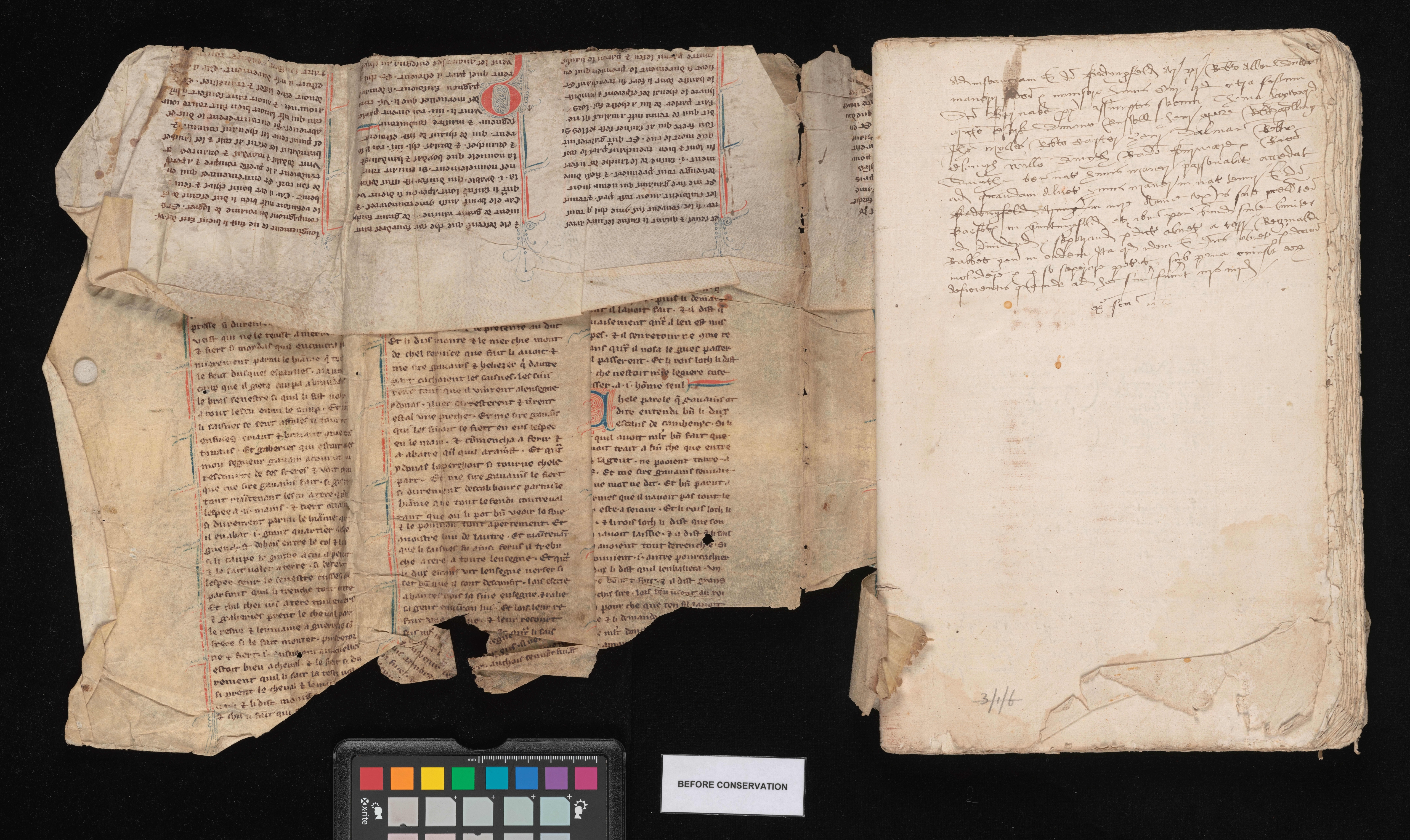Part of a 13th century manuscript containing rare stories about Merlin and King Arthur has been discovered at Cambridge University Library. The remarkable text had been repurposed as binding for a 16th century archival register, remaining hidden from view until it was rediscovered in 2019.
The manuscript contains part the Suite Vulgate du Merlin, a sequel to the story of King Arthur that was popular in the medieval period. The story formed the second part of the Lancelot-Grail cycle, describing the events at Arthur’s court after his coronation. Despite it effectively being a bestseller in its day, there are remarkably few copies of the Suite Vulgate du Merlin left in the world. In fact, there are only 40 surviving copies, each handwritten by individual medieval scribes.
This recently discovered copy is thought to have been written between 1275 and 1315. At some time in the 1500s however, it was recycled and used as the cover for a property record for Huntingfield Manor, Suffolk, England, which was owned by the Vanneck family. Unfortunately, this repurposing process meant the manuscript was folded up, torn, and stitched into the new book’s binding. However, the University’s scholars were able to recover the document’s long-lost words using new digital imaging technologies, allowing us to learn exactly what it originally said.
“It was first thought to be a 14th century story about Sir Gawain but further examination revealed it to be part of the Old French Vulgate Merlin sequel, a different and extremely significant Arthurian text,” Dr Irène Fabry-Tehranchi, French Specialist in Collections and Academic Liaison at Cambridge University Library, explained in a statement.
As each of these manuscripts were written by individual scribes, they can contain idiosyncrasies that hint at their lineage. For instance, this fragment belongs to the short version of the Vulgate Merlin, and contains small errors such as the mistaken use of the name “Dorilas” instead of “Dodalis”.

The manuscript is a fragment containing parts of two important stories concerning the mythical King Arthur and Merlin.
Image courtesy of Cambridge University Library
The reconstruction of the manuscript took the team three years to complete, but it is now available to both scholars and the public in virtual form.
“If this had been done 30 years ago, the fragment might have been cut, unfolded, and flattened,” Fabry-Tehranchi added. “But today, preserving it in situ gives us a crucial insight into 16th-century archival practices, as well as access to the medieval story itself. It’s not just about the text itself, but also about the material artefact – it’s a piece of history in its own right.”
The manuscript was written in Old French, which was the language of the medieval English aristocracy after the Norman Conquest. It recounts two important episodes from the Suite Vulgate du Merlin, including the Battle of Cambénic, where Christians overcome the Saxons. The main characters are the Excalibur-wielding Gauvain on his horse; Gringalet; his brother; and his father, King Loth, as they fight the Saxon forces of kings Dodalis, Moydas, Oriancés, and Brandalus.
Then there’s the story of Merlin at Arthur’s Court, where the famous wizard appears to Arthur’s court during the Feast of the Assumption of the Virgin Mary, disguised as a harpist. It is here that Merlin demonstrates his magical abilities and the importance of his role as Arthur’s advisor.
Digital reconstruction
Once the manuscript fragment was discovered, an extensive conservation project was established to reconstruct the text at the University Library’s Cultural Heritage Imaging Laboratory (CHIL). Obviously, the fragment was extremely fragile, so traditional conservation methods posed a significant risk to this centuries-old text. To avoid further damage, a multidisciplinary team from across the University of Cambridge collaborated with the CHIL to analyze and digitize it.
The work of Amélie Deblauwe, Błażej Mikuła, and Maciej Pawlikowski from CHIL, with the support of Jennifer Murray from the Library’s Conservation Department, unfolded the fragments virtually, allowing us to read the lost writing. The team used multispectral imaging (MSI) to capture images across various wavelengths of light to enhance their readability. This also allowed the team to identify any folded or erased text.
They also used computed tomography (CT) scanning, which is usually used on fossils, to analyze the structure of the book’s binding without destroying it.
Given that manuscript’s condition, the team had to use mirrors, prisms, magnets and others methods to photograph each section of the folded text, resulting in hundreds of images that could then be assembled digitally, like a jigsaw puzzle. This eventually produced a full 3D model of the unfolded manuscript.
“This project was a fabulous opportunity to employ all possible advanced imaging techniques from our photographic arsenal. And each of them brought something very important to light. This resulted in the creation of a set of unique digital objects which placed the original fragment in a whole new context and has transformed our understanding of it,” Maciej M. Pawlikowski, Head of CHIL, explained.
This project not only reconstructed an important part of a lost and rare manuscript, it also sets standards for the non-invasive study of medieval manuscripts. The imaging techniques the team pioneered are already getting attention from other institutes, such as the UK’s National Archives.
The successful digitization of the Merlin manuscript can now be seen at the Cambridge Digital Library, where it can be examined by anyone interested in this remarkable piece of history.
Source Link: Rare Stories About Merlin And King Arthur Digitally Reconstructed From Circa 13th Century Text